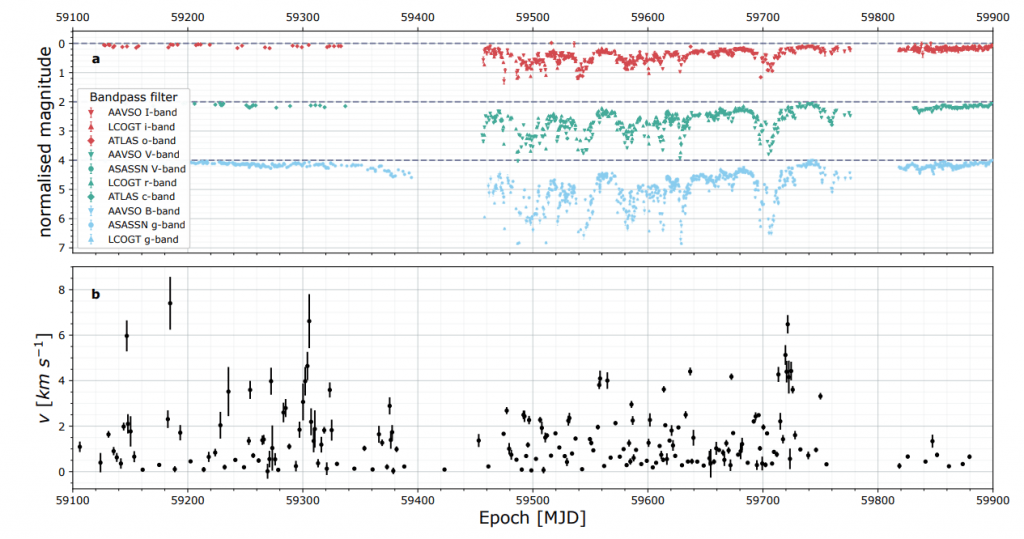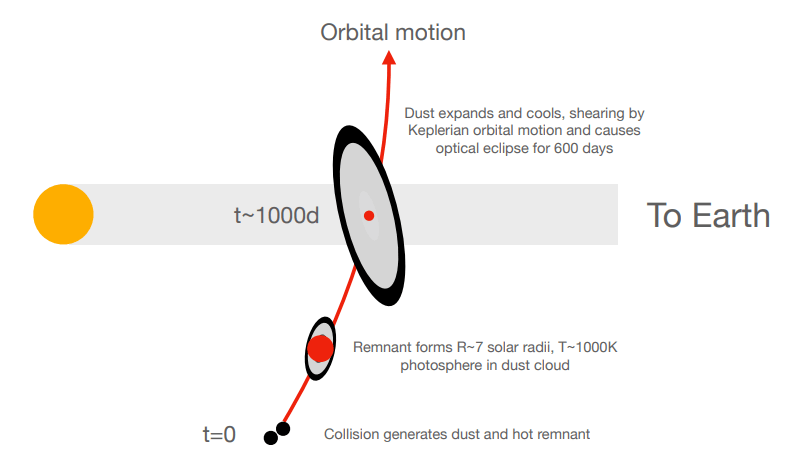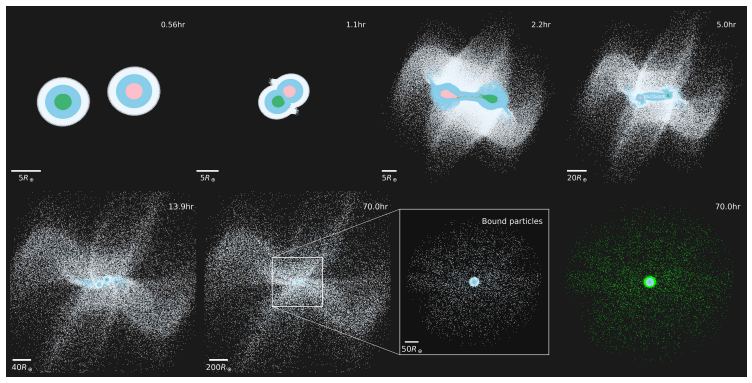What would happen if two giant planets collided? It would be terrifying to behold if it happened in our Solar System. Imagine if Neptune and Uranus slammed into each other. Picture the chaos as a new super-heated object took their places, and clouds of debris blocked out the Sun. Think of the monumental destruction as objects are sent careening into each other.
Astronomers spotted the aftermath of a gigantic planetary collision like this in a distant solar system. From a safe distance, they were surprised and intrigued rather than terrified. Now, they intend to keep watching as the aftermath unfolds.
It all started several years ago. An astronomer noticed that an otherwise ordinary star had a strange light curve. It suddenly brightened in infrared light, and the brightening lasted about 1,000 days. Then, a period of optical dimming started in December 2021 and lasted for about 500 days. The light curve caught the attention of other astronomers.
"I knew then this was an unusual event."Dr. Matthew Kenworthy, Leiden University.
An international team of astronomers studied the star and its light curve and published their results in the journal Nature. The study is titled " A planetary collision afterglow and transit of the resultant debris cloud. " The lead authors are Dr. Matthew Kenworthy from Leiden University and Dr. Simon Lock, a Research Fellow in Earth Sciences at the University of Bristol.
The brightening and dimming of the star was spotted by the All-Sky Automated Survey for SuperNovae (ASASSN,) which looks for transient light signals that indicate an active supernova. The unusual light curve was not a supernova, but astronomers could tell right away it was something worth keeping an eye on. "Follow-up observations of this very unusual object are strongly encouraged," wrote the Astronomer's Telegram when they reported the finding. That was a universal response among astronomers.
"An astronomer on social media pointed out that the star brightened up in the infrared over a thousand days before the optical fading," said co-lead author Kenworthy. "I knew then this was an unusual event."
Interest grew, and Kenworthy and other astronomers started watching the star, now named ASASSN-21qj.
"To be honest, this observation was a complete surprise to me," said Kenworthy. "When we originally shared the visible light curve of this star with other astronomers, we started watching it with a network of other telescopes."
After gathering all of the light curves and observational data they could, the researchers puzzled over the cause. They used simulations to help figure out what they were seeing. At first, they weren't certain.
They wondered if the initial brightening and subsequent dimming could be totally unrelated events. They also thought that there could've been a collision between two giant plants that created only a debris cloud. This cloud would've been only 0.1 AU from the star.
But after simulations and study, the researchers settled on a collision between two massive planets, several AU from the star. Each planet had roughly 25 Earth masses, and the collision velocity was 45.77 km s-1. But the collision created more than just debris.
They concluded that two giant planets had collided and that the collision also produced a newly formed object called a synestia, a doughnut-shaped mass of hot vaporized rock spinning rapidly. The intense blast of infrared came from the synestia's heat.
So the collision created two things: a massive debris cloud and a new planet-size object. And the objects that collided were both ice-giant planets much larger than Earth.
"Our calculations and computer models indicate the temperature and size of the glowing material, as well as the amount of time the glow has lasted, is consistent with the collision of two ice giant exoplanets," said co-lead author Lock.
These planets were far more massive than Earth, and the energy the collision released would've been stupefying. The resulting synestia could've been hundreds of times larger than Earth, super-heated, and spinning rapidly. The collision and the resulting object explain the infrared brightening, but what about the dimming period that followed it?
That's because of the expanding debris cloud. The shower of debris would've been equally as spectacular if viewed from a closer vantage point. Alongside the collision and the resulting synestia, the cloud would've changed the nature of the solar system. But all astronomers could see was the optical dimming as the cloud passed in front of the star three years after the infrared-bright period. We can only imagine what it might've looked like.
In the future, the cloud will elongate as it orbits the star along with the post-collision body. That will scatter the star's light, and telescopes like the JWST should be able to tell us more. The synestia will cool, too, and become a new planet orbiting the star. There may even be new moons.
"It will be fascinating to observe further developments," said co-author Dr. Zoe Leinhardt. "Ultimately, the mass of material around the remnant may condense to form a retinue of moons that will orbit around this new planet."
How did this all happen?
ASASSN-21qj is only about 300 million years old. At that age, the gas component in its protoplanetary disk was largely removed, and its removal makes collisions like this more likely. Our own Solar System experienced a similar collision between Earth and the protoplanet Theia early in its history. It created a cloud of vapour that eventually coalesced into the Earth and the Moon. There were likely other collisions like this in our Solar System's early years.
What astronomers are seeing at ASASSN-21qj is similar but on a much more massive scale. If they keep watching for long enough, they'll certainly see the dust cloud elongate. But the exact nature of the resulting planet and any moons won't reveal itself for a long time. All we have for now are models, and they're not very reliable in this scenario.
"Given the limitations of SPH (smoothed particle hydrodynamics) simulations, it is not possible to accurately determine the initial structure of post-impact bodies in the relevant regime," the authors write.
We'll have to watch this system for an extremely long time to find out how things turn out and what type of planet forms. Humanity may not last long enough. But maybe astronomers won't have to wait. If they can locate more of these unusual light curves—and the upcoming Vera Rubin Observatory will specialize in sensing these types of transient events— astronomers could begin to understand these collisions, how common they are, and what types of objects form as a result.
 Universe Today
Universe Today




